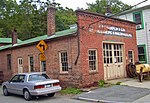Bull Hill

Bull Hill, also known as Mount Taurus, is a mountain north of the village of Cold Spring on the Hudson River in Putnam County in the State of New York. It is part of the river-straddling range known as the Hudson Highlands. The original name came after a bull that used to terrorize the mountain was chased by indignant inhabitants. A hunting party drove the bull over the hill. In an attempt to flee the mountaineers, the bull plunged out into space and fell down. Its broken and shapeless mass on the rocks was memorialized in the name of the mountain the bull used to haunt.While not as well known as neighboring Breakneck Ridge or Storm King Mountain across the river, it too is part of Hudson Highlands State Park and has an extensive trail system and offers hikers sweeping views of the river and neighboring peaks from rock outcrops near its wooded 1,420-foot (433 m) summit, higher than both neighbors.
Excerpt from the Wikipedia article Bull Hill (License: CC BY-SA 3.0, Authors, Images).Bull Hill
Geographical coordinates (GPS) Address Phone number Website Nearby Places Show on map
Geographical coordinates (GPS)
| Latitude | Longitude |
|---|---|
| N 41.438333333333 ° | E -73.955555555556 ° |
Address
Hudson Highlands State Park
10516
New York, United States
Open on Google Maps











